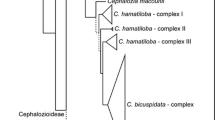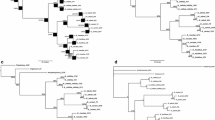Abstract
Chloroplast DNA restriction-site variation was analyzed in 30 accessions representing 20 species from the major lineages in Thlaspi s.l. (previously described as genera by Meyer 1973, 1979) and allied genera from the subtribe Thlaspidinae (Peltaria, Teesdalia, Cochlearia, Ionopsidium, Aethionema). A total of 161 variable restriction sites were detected. Phylogenetic analyses indicated a division of Thlaspi s.l. into three groups consistent with Meyer's genera Thlaspi s. str., Microthlaspi and Noccaea/Raparia. The genus Thlaspi s.l. as currently described proved to be paraphyletic because one of its major lineages, i.e. Thlaspi s. str., appeared to be more closely related to other genera (Peltaria, Teesdalia) than to the remaining lineages of Thlaspi s.l., i.e. Noccaea/Raparia and Microthlaspi. Sequence divergence values (100 x p) between the Thlaspi s.l. lineages were similar to values between these groups and related genera (Teesdalia, Peltaria), respectively. Chloroplast DNA variation was also used to assess subtribal classification of the genera studied. The cpDNA data were inconsistent with the controversial taxonomic classifications based on morphology. The molecular data would suggest that (1) the subtribe Thlaspidinae, as traditionally described, is not monophyletic; (2) the Thlaspidinae should be reduced to a group consisting of Thlaspi s. str., Peltaria, Teesdalia, Microthlaspi, Noccaea/Raparia, and that Aethionema should be excluded from the Thlaspidinae; and (3) Cochlearia and Ionopsidium represent the subtribe Cochleariinae.
Similar content being viewed by others
References
Albert VA, Mishler BD, Chase MW (1992) Character-state weighting for restriction-site data in phylogenetic reconstruction, with examples form chloroplast DNA. In: Soltis PS, Soltis DE, Doyle JJ (eds) Molecular systematics of plants. Chapman and Hall, New York, pp 369–401
Al-Shehbaz IA (1984) The tribes of Cruciferae (Brassicaceae) in the southeastern United States. J Arnold Arbor 65:343–373
Al-Shehbaz IA (1985) The genera of Thelypodieae (Cruciferae; Brassicaceae) in the southeastern United States. J Arnold Arbor 66:85–111
Al-Shehbaz IA (1986) The genera of Lepidieae (Cruciferae; Brassicaceae) in the southeastern United States. J Arnold Arbor 67:265–311
Avetisian VE (1983) The system of the family Brassicaceae. Bot Zhur 68:1297–1305
Avetisian VE, Fursa NS (1990) The importance of low molecular compounds for the systematics of the family Brassicaceae. Bot Zhur 75:192–199
Ball PW, Heywood VH, Akeroyd JR (1993) Cruciferae. In: Tutin TG, Surges NA, Chater OA, Edmonson JR, Heywood VH, Moore DM, Valentine DH, Walters SM, Webb DA (eds) Flora Europaea, 2nd edn, vol 1. Cambridge University Press, Cambridge, 313–417
Bruneau A, Doyle JJ (1993) Cladistic analysis of cpDNA restrictionsite characters in Erythrina (Leguminosae: Phaseoleae). Syst Bot 18:229–247
Chase MW, Hills HH (1991) Silica gel: An ideal material for field preservation of leaf samples for DNA studies. Taxon 40:215–220
Doyle JJ, Doyle JL (1987) A rapid DNA isolation procedure for small quantities of fresh leaf tissue. Phytochem Bull 19:11–15
Dvorak F (1971) On the evolutionary relationships in the family Brassicaceae. Feddes Repert 82:357–372
Fahleson J, Eriksson I, Glimelius K (1993) Intertribal somatic hybrids between Brassica napus and Barbarea vulgaris. Plant Cell Rep 13:411–416
Fahleson J, Eriksson I, Lundgren M, Stymne S, Glimelius K (1994) Intertribal somatic hybrids between Brassica napus and Thlaspi perfoliatum expressing T. perfoliatum — specific gene(s) for nervonic acid biosynthesis. Theor Appl Genet 87:795–804
Felsenstein J (1985) Confidence limits on phylogenies: an approach using the bootstrap. Evolution 93:783–791
Greuter W, Burdet HM, Long G (eds) (1986) Med-checklist, vol 3, Dicotyledones, Cruciferae. Conservatoire et Jardin Botaniques de la Ville de Genève, OPTIMA, Geneva, pp 34–172
Hauser LA, Crovello TJ (1982) Numerical analysis of generic relationships in the Thelypodieae (Brassicaceae). Syst Bot 7:249–268
Hayek A (1911) Entwurf eines Cruciferensystems auf phylogenetischer Grundlage. Beih Bot Centralbl 27:127–335
Hedge IC (1976) A systematic and geographical survey of the Old World Cruciferae. In: Vaughan JG, MacLeod AJ, Jones MB (eds) The biology and chemistry of the Cruciferae. Academic Press, London, pp 1–45
Hillis DM, Bull JJ (1993) An empirical test of bootstrapping as a method for assessing confidence in phylogenetic analysis. Syst Biol 42:182–192
Hillis DM, Huelsenbeck JP (1992) Signal, noise, and reliability in molecular phylogenetic analyses. J Hered 83:189–195
Holsinger KE, Jansen RK (1993) Phylogenetic analysis of restrictionsite data. Methods Enzymol 224:439–455
Janchen E (1942) Das System der Cruciferen. Österr Bot Zeitschr 91:1–21
Jansen RK, Holsinger KE, Michaels HJ, Palmer JD (1990) Phylogenetic analysis of cpDNA restriction-site data at higher taxonomic levels: an example from the Asteraceae. Evolution 44:2089–2105
Kumar PR, Tsunoda S (1980) Variation in oil content and fatty acid composition among seeds from the Cruciferae. In: Tsunoda S, Hinata K, Gómez-Campo C (eds) Brassica crops and wild allies. Japan Scientific Societies Press. Tokyo, pp 235–252
Meyer FK (1973) Conspectus der “Thlaspi” Arten Europas, Afrikas und Vorderasiens. Feddes Repert 84:449–470
Meyer FK (1979) Kritische Revision der “Thlaspi” Arten Europas, Afrikas und Vorderasiens. Feddes Repert 90:129–154
Meyer FK (1991) Seed-coat anatomy as a character for a new classification of Thlaspi. Flora et Veg Mundi 9:9–15
Mummenhoff K, Koch M (1994) Chloroplast DNA restriction-site variation and phylogenetic relationships in the genus Thlaspi sensu lato (Brassicaceae). Syst Bot 19:73–88
Mummenhoff K, Zunk K (1991) Should Thlaspi (Brassicaceae) be split? Preliminary evidence from isoelectric-focusing analysis of Rubisco. Taxon 40:427–434
Mummenhoff K, Kuhnt E, Koch M, Zunk K (1995) Systematic implications of chloroplast DNA variation in Lepidium (Brassicaceae), sections Cardamon, Lepiocardamon and Lepia. Plant Syst Evol 196:75–88
Nei M, Li W (1979) Mathematical model for studying genetic variation in terms of restriction endonucleases. Proc Natl Acad Sci USA: 5268–5273
Olmstead RG, Palmer JD (1994) Chloroplast DNA systematics: a review of methods and data analysis. Am J Bot 81:1205–1224
Price RA, Al-Shehbaz IA, Palmer JD (1994) Systematic relationships of Arabidopsis: a molecular and morphological perspective. In: Meyerowitz EM, Somerville C (eds) Arabidopsis. Cold Spring Harbor Press, New York, pp 6–19
Reeves RD (1988) Nickel and zinc accumulation by species of Thlaspi L., Cochlearia L., and other genera of Brassicaceae. Taxon 37:309–318
Rodman JE (1991) A taxonomic analysis of glucosinolate-producing plants, part 2: cladistics. Syst Bot 16:619–629
Rodman JE, Price RA, Karol K, Conti E, Sytsma KJ, Palmer JD (1993) Nucleotide sequences of the rbcL gene indicate monophyly of mustard oil plants. Ann Missouri Bot Gard 80:686–699
Schultze-Motel W (ed) (1986) Cruciferae. In: Illustrierte Flora von Mitteleuropa, 3rd edn., vol IV, 1. Parey, Berlin
Schulz OE (1936) Cruciferae. In: Engler A, Prantl K (eds) Die natürlichen Pflanzenfamilien, 17b. Engelmann, Leipzig, pp 227–658
Swofford DL (1991) PAUP. Phylogenetic analysis using parsimony, version 3.1 for Macintosh. Computer package. Illinois Nat Hist Survey, Champaign
Sytsma, KJ (1990) DNA and morphology: Inference of plant phylogeny. Trends Ecol Evol 5:104–110
Warwick SI, Black LD (1991) Molecular systematics of Brassica and allied genera (subtribe Brassicinae, Brassiceae) — chloroplast genome and cytodeme congruence. Theor Appl Genet 82:81–92
Warwick SI, Black LD, Aguinagalde I (1992) Molecular systematics of Brassica and allied genera (subtribe Brassicinae, Brassiceae) — chloroplast DNA variation in the genus Diplotaxis. Theor Appl Genet 83:839–850
Author information
Authors and Affiliations
Additional information
Communicated by R. Hagemann
Rights and permissions
About this article
Cite this article
Zunk, K., Mummenhoff, K., Koch, M. et al. Phylogenetic relationships of Thlaspi s.l. (subtribe Thlaspidinae, Lepidieae) and allied genera based on chloroplast DNA restriction-site variation. Theoret. Appl. Genetics 92, 375–381 (1996). https://doi.org/10.1007/BF00223682
Received:
Accepted:
Issue Date:
DOI: https://doi.org/10.1007/BF00223682




